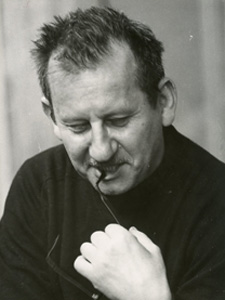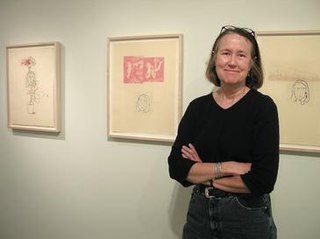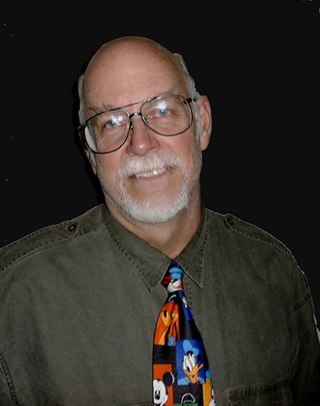
Jim Dine is an American artist. Dine's work includes painting, drawing, printmaking, sculpture and photography; his early works encompassed assemblage and happenings, while in recent years his poetry output, both in publications and readings, has increased.

Gertrud Louise Goldschmidt, known as Gego, was a modern German-Venezuelan visual artist. Gego is perhaps best known for her geometric and kinetic sculptures made in the 1960s and 1970s, which she described as "drawings without paper".
David L. Faber is an American master printer, and is Professor of Art and Head of Printmaking at Wake Forest University.
Martin Lewis was an Australian-born American etcher.

Vitreography is a fine art printmaking technique that uses a 3⁄8-inch-thick (9.5 mm) float glass matrix instead of the traditional matrices of metal, wood or stone. A print created using the technique is called a vitreograph. Unlike a monotype, in which ink is painted onto a smooth glass plate and transferred to paper to produce a unique work, the vitreograph technique involves fixing the imagery in, or on, the glass plate. This allows the production of an edition of prints.
Ken Kerslake (1930–2007) was a printmaker and professor credited with being "one of a handful of printmaker-educators responsible for the growth of printmaking in the southeast in the years following World War II." Kerslake taught at the University of Florida in Gainesville, which gave him the title of Distinguished Service Professor Emeritus after his retirement.
Glen Alps (1914-1996) was a printmaker and educator who is credited with having developed the collagraph. A collagraph is a print whose plate is a board or other substrate onto which textured materials are glued. The plate may be inked for printing in either the intaglio or the relief manner and then printed onto paper. Although the inventor of the process is not known, Alps made collagraphy his primary art form and coined the word "collagraph" in 1956. He disseminated the techniques he developed for making collagraphs during his long career as both an artist and a teacher.

Elizabeth Olds was an American artist known for her work in developing silkscreen as a fine arts medium. She was a painter and illustrator, but is primarily known as a printmaker, using silkscreen, woodcut, lithography processes. In 1926, she became the first woman honored with the Guggenheim Fellowship. She studied under George Luks, was a Social Realist, and worked for the Public Works of Art Project and Federal Art Project during the Great Depression. In her later career, Olds wrote and illustrated six children's books.
Carol Wax is an American artist, author and teacher whom the New York Times called "a virtuoso printmaker and art historian" for her work in mezzotint and her writings on the history and technique of that medium.

Ericka Walker is an American artist and printmaker. She lives and works in Halifax, Nova Scotia, Canada.
Andrew Stein Raftery is an American artist and educator, known for his paintings, burin engravings, and drawings on fictional and autobiographical narratives of contemporary American life.

Mauricio Leib Lasansky was an Argentine artist and educator known both for his advanced techniques in intaglio printmaking and for a series of 33 pencil drawings from the 1960s titled "The Nazi Drawings." Lasansky, who migrated to and became a citizen of the United States, established the school of printmaking at the University of Iowa, which offered the first Master of Fine Arts program in the field in the United States. Sotheby's identifies him as one of the fathers of modern printmaking.
Robert Kipniss is an American painter and printmaker. His mature paintings, lithographs, mezzotints, and drypoints share stylistic characteristics and subject matter and typically depict trees seen close up or at varying distances in fields. Other works show one or more houses in a landscape or town setting. Some are interiors with a view toward a window or with a still life set close to one, frequently with a landscape beyond. No human figures are present, and all forms are reduced to essentials. The time is often dusk or nighttime. Kipniss' use of exceptionally subtle black and white tones or, less often, lightly toned hues creates an overall atmospheric effect. His works have been described as conveying solitude and inward experience. Kipniss often uses the subject matter of a painting in a lithograph or mezzotint, sometimes with variations. His paintings date from the early 1950s. His main body of prints are lithographs and mezzotints, the former dating from 1968 into 1994, the latter since 1990.

Barbara Tisserat (1951–2017) was an American artist and lithographer born in Denver, Colorado. She taught lithography at Virginia Commonwealth University's School of the Arts. She was a member of One/Off Printmakers and also taught at the Virginia Museum of Fine Arts Robinson House lithography workshop with Marilyn Bevilacqua. She was active with the Richmond Printmaking Workshop and served on the Advisory Board of Studio Two-Three in Richmond, Virginia. She was a member of the Summer 2007 graphics faculty at Haystack Mountain School of Crafts and was a visiting artist and lecturer in the Lyceum program at Emory and Henry College.
Osmeivy Ortega Pacheco is a Cuban visual artist based in Havana, Cuba. He works primarily in large-scale, monochromatic lithographs featuring the human body and animals.
Master printmakers or master printers are specialized technicians who hand-print editions of works of an artist in printmaking. Master printmakers often own and/or operate their own printmaking studio or print shop. Business activities of a Master printshop may include: publishing and printing services, educational workshops or classes, mentorship of artists, and artist residencies.

Bob Evermon is a studio artist and academic. He is a Professor Emeritus at Emily Carr University of Art and Design.
Mary Teichman is an American artist and printmaker known for her color aquatint etchings.
This is a timeline of 20th-century printmaking in America.

Creighton Michael is an American abstract artist. He earned his B.F.A. in painting from the University of Tennessee, his M.A. in art history from Vanderbilt University, and later received an M.F.A. in painting and multimedia from Washington University in St. Louis.









